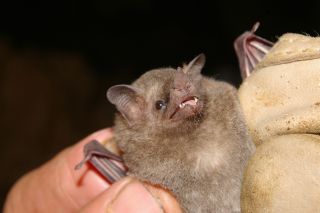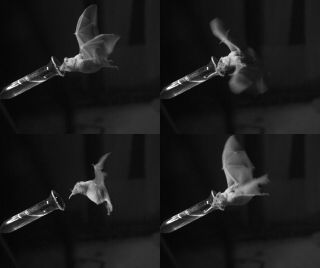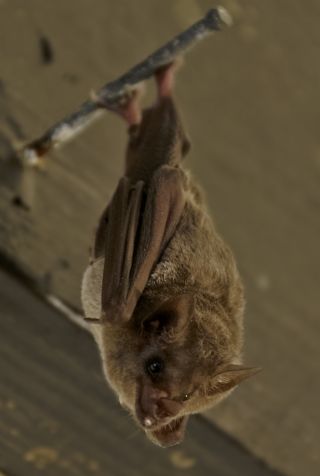Memory
Bats’ Whiskers Aid in Feeding From Flowers
Nectar-eating bats use their long whiskers to fine-tune hovering flight.
Posted February 8, 2023 Reviewed by Gary Drevitch
Key points
- When scientists trimmed the whiskers of nectar-eating bats, their flight trajectory and approach to flowers changed.
- Bats that rely on nectar, and hover to access it from flowers, have longer whiskers than bats that eat little or no nectar.
- Whiskers provide up-close sensory information for nectar-eating bats to fine-tune their hovering flight.

When biologist Eran Amichai got his first close-up view of a nectar-eating bat about ten years ago, he couldn’t help but notice its whiskers.
“They were completely different from those of all the bats I’d seen before,” he says.
Amichai, now at Dartmouth University, says that most bats have little whiskers here and there on their faces. But nectar-eating bats have very long whiskers that are arranged around their muzzles almost like a brush pointing forward.
“I immediately thought, this must be connected to how they feed,” he says. Like hummingbirds, nectar-eating bats have evolved to hover in front of flowers to access the nectar inside.
The idea stuck with Amichai as he worked on other projects. Then about three years ago, an opportunity arose to collaborate with Sharon Swartz of Brown University, Rachel Page of the Smithsonian Tropical Research Institute, David Boerma of the American Museum of Natural History, and Hannah ter Hofstede at Dartmouth to tackle his suspicions about nectar-eating bats’ whiskers. The team’s results were just published in the journal Proceedings of the Royal Society B.
Flower Power
First, Amichai and his colleagues trained 11 wild-caught nectar-eating bats (Glossophaga soricina) to fly in an experimental room and feed from specially made transparent glass flowers. From outside the room, Amichai recorded feeding events using two synchronized high-speed cameras and infrared illumination.
After letting the bats acclimate and feed for a few days, Amichai trimmed their whiskers to see whether it would change their approach to and positioning within the flowers. The researchers analyzed the videos by tracking points of reference on the bats’ heads as they hovered and fed with intact versus clipped whiskers.

The team expected to see differences in feeding duration when whiskers were clipped. With whiskers intact, feeding events are very fast—about half a second long. But the bats were just as quick when their whiskers were clipped.
Amichai thinks that the experimental bats may have been just as fast with their whiskers clipped because they learned that the glass flowers were stable and held a lot of nectar. The bats were not strongly motivated to minimize their feeding time.
What Whiskers Do
The researchers did find other differences in how the bats fed. With whiskers clipped, the bats’ vertical and lateral positioning in the flower was affected. The bats entered the flower closer to the flower wall when their whiskers had been clipped. Amichai says that if the flowers were less stable (as they are in natural conditions), the bats’ movements would likely move the flower and create vibrations that could either alert predators to the bats’ presence and/or cause the flower to dip and spill the nectar.
“We think these are the two main advantages of having those whiskers,” he says. “The bat can know exactly where it is in the flower and control its position in a way to minimize vibration and minimize risk of spilling that nectar.”
The researchers point out that although they only quantified the positioning of the bats’ heads inside the flowers, the information that they get from their whiskers probably affects the entire kinematics of flight.
“It is very likely that with the whiskers clipped, the bat had to do more corrections of the body and wings, while trying to keep the head relatively stable,” says Amichai. “The fact that we still saw some differences in head positioning suggests there are probably much larger effects when you look at things like roll and pitch and wing movements.”
_(7098928383).jpg?itok=dUM3_CzL)
By a Whisker
In the second part of the experiment, Amichai and his colleagues measured the whisker length of different bat species from museum specimens. They compared the ratio between whisker length and the width of the skull at the end of the muzzle and compared it to the bats’ diets. The team examined species that almost exclusively eat nectar, species that eat nectar among other items (like fruit), and species that don’t eat nectar at all (insect-eating bats).
They found that bats that rely on nectar for their diet have significantly longer whiskers compared to species that eat little or no nectar. Among the nectar-eating bats were some distantly related species, showing that long whiskers may be a common sensory mechanism in nectar specialists—i.e., those that hover to access nectar.
A Hidden Sensory World
“The entire field of animal behavior is reliant on our understanding of the sensory input of the animals we are studying,” says Amichai.

To illustrate, he breaks down how these nectar-eating bats leave their roost in the evening to feed: Upon first leaving its roost, the bat relies on spatial memory, and perhaps memory of flowering seasons, to get to an area of jungle with the right trees. It uses a combination of vision and echolocation to fly there without colliding into obstacles, as well as following the scent of the flowers to locate the specific tree. Vision and echolocation may help the bat identify a particular bloom from which to feed, but these senses won’t help it as it gets very close to an individual flower. This is where it starts to rely on its whiskers to fine-tune its hovering flight and final approach to access the food.
“To me, it’s just mind-blowing to think about how such different types of information from completely separate senses are all integrated seamlessly in the bat’s brain,” says Amichai. “When we think about it in sensory terms, even this very basic task for the bat reveals a complex sensory world.”
References
Amichai E, Boerma DB, Page RA, Swartz SM, and ter Hofstede HM. 2023. By a whisker: the sensory role of vibrissae in hovering flight in nectarivorous bats. Proc. R. Soc. B. 290: 2022208520222085.




